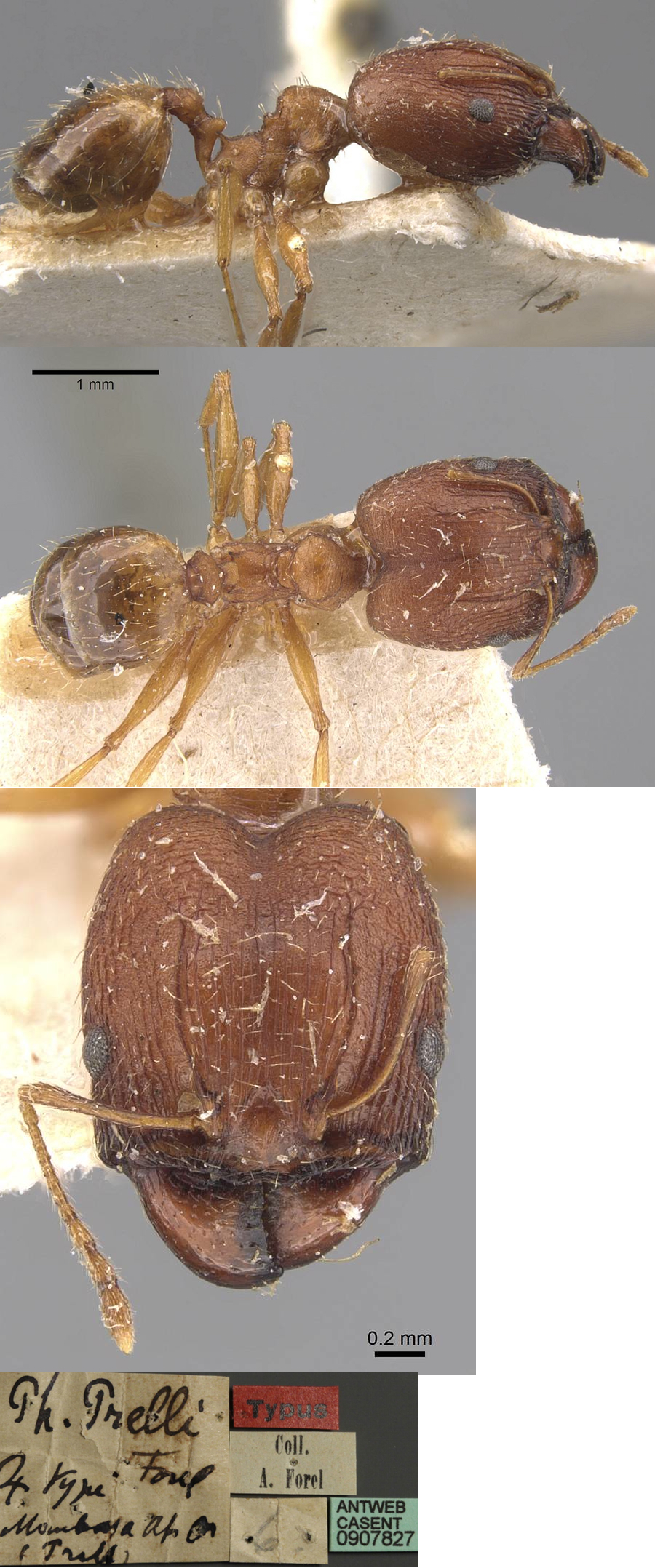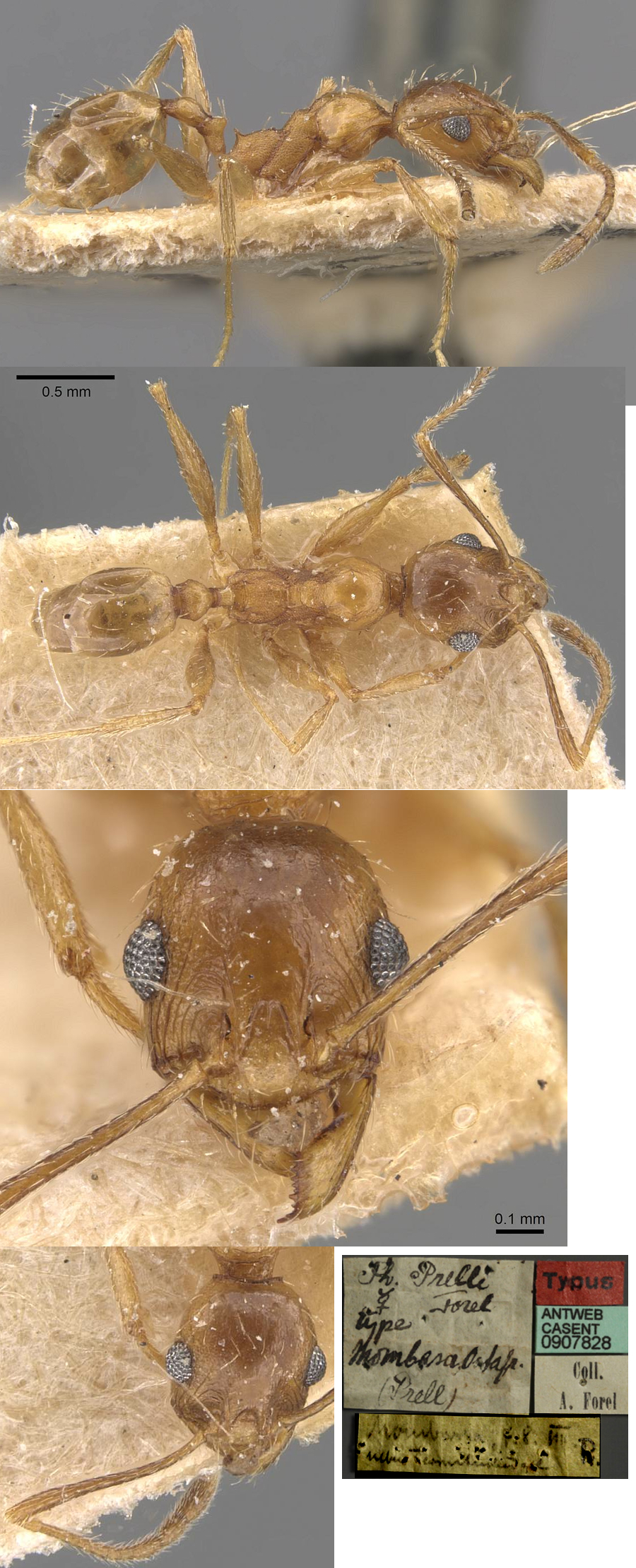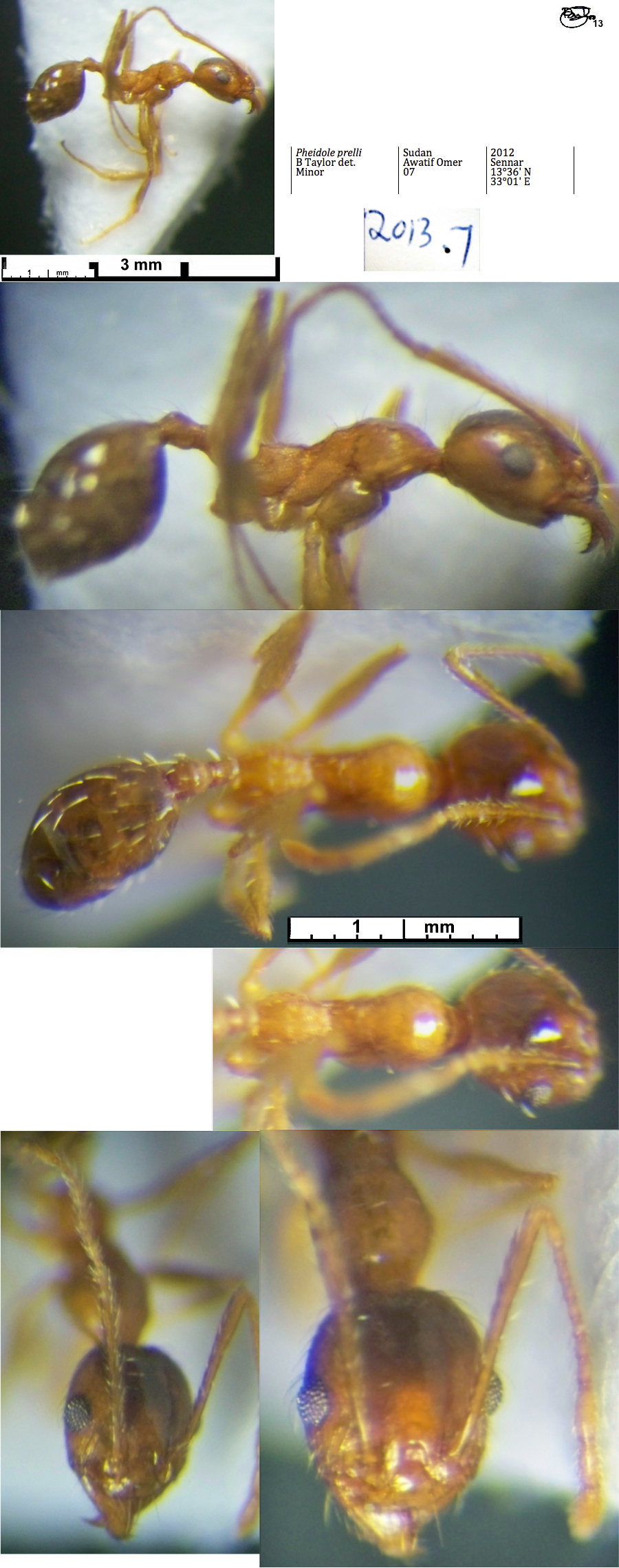Pheidole prelli Forel
  Type location Kenya (Pheidole Prelli n. sp., Forel,
1911d: 362, all forms) from Mombasa, Prell - see below Type location Kenya (Pheidole Prelli n. sp., Forel,
1911d: 362, all forms) from Mombasa, Prell - see below
all forms
described (see Bolton, 1995)  . .
|
Pheidole redbankensis has been
separated here. The type major
is quite different to that of prelli.
It is the form shown in
Arnold's drawing of "P. prelli"
(1920) and has a shorter head that is
widest at the occiput and not an elongated
oval; with very different sculpture; the postpetiole is much wider, a
flattened triangle from above. The minor has a similar gross morphology
but again differs significantly; the mandibles are more formidable,
there is a well defined nuchal collar (not on prelli), the propodeal spines are
slightly large and the postpetiole is swollen in profile and from
above. The politocciput form
is a junior synonym of redbankensis.
|
Forel's
(1911d) description is at  and and  . .
|
Forel's description (1911d) was -
MAJOR - TL 3.7-4.2 mm; mandibles smooth, with sparse
fine puncturation giving rise to hairs. Clypeus without carinae,
anterior border broadly and medially scalloped. Head rectangular a
third longer than wide, distinctly attenuated behind the eyes (the
occiput narrower than the rest). Eyes slightly forward of the anterior
quarter. Occipital impression strong, with the occipital lobes convex;
postclypeal notch distinct. Frontal carinae as long as the scapes,
slightly divergent, convex on the outside, forming the edge of a
narrow, superficial scrobe; area between carinae and first rugae of
cheeks superficially and finely reticulo-punctate. From the open
extremity of the scrobe to the eye the head has a shallow depression.
The scape is strongly curved in the basal half, and hardly exceeds the
median line of the head; funiculus with median segments slightly longer
than wide. Pronotum with obtuse upper tubercles. Anterior of mesonotum
with a strong obtuse transverse ridge, behind which is a deep groove
with a vertical anterior face; the groove being followed by a very high
transverse roll. Dorsum of propodeum is square, with a small anterior
and lateral border; spines strong and longer than 75% the basal
separation. Petiole node a thick scale, with smooth summit. Postpetiole
hexagonal, wider than long, sides conical, almost three times as wide
as the petiole node.
Head subopaque, longitudinally rugose, with fine irregular reticulation
between the rugae. Whole of occiput and posterior vertex almost matt,
densely and as finely laterally striate. On sides of head rugae
contorted, becoming reticulate where the transverse striae of the
vertex cross the rugae. Thorax and pedicel subopaque, finely
reticulate; the former overall irregularly rugose across. Base of
gaster feebly reticulate, rest shiny.
Whole body with sparse yellowish hairs, none on the tibiae; 2-3 hairs
on the scapes. Close pubescence on the tibiae and scapes, otherwise
very sparse. Overall rust-red; gaster yellower, more brown in posterior
half; mandibles and scapes brown rust; lower legs and funiculi
yellowish.
|
MINOR
- TL 2.5 mm; mandibles striated and pubescent; anterior border entirely
denticulate. Head an eighth longer than wide, slightly narrowed
posteriorly, rectangular with a somewhat distinct posterior border,
convex. Clypeus without carinae. Frontal carinae parallel, reaching
about the midpoint but not forming a distinct scrobe; even so, between
the carinae and the first rugae of the genae the antennal socket is
distinctly raised in a transverse arc, prolonged slightly forward. Eyes
convex slightly forward of the midpoint. Scape surpassing the occiput
by about one-third its length. Thorax as in the soldier but more
elongated, with less pronounced structures; propodeal dorsum one-third
longer than wide; spines twice as long as the basal separation;
declivity short. Postpetiole as long as wide; rest as soldier.
Head quite shiny, finely and irregularly reticulate, with oblique rugae
between the eyes and the frontal carinae, arcing into the anterior
sockets. Thorax densely reticulo-punctate and almost matte, except on
the pronotum, where the dorsum is near smooth. Petiole node reticulate;
rest shiny. Pilosity and pubescence as in the soldier. Overall
yellow-rust; head, antennae and vague bands on the gaster brownish.
QUEEN also described, TL 6.2 mm; mostly as the major,
head square, slightly enlarged behind.
MALE TL 4 mm; mandibles striated and with three teeth;
scape enlarged apically about three times longer than wide; head
trapezoidal, narrowed behind; thorax twice as big as head; mesonotum
higher than pronotum.
Collected at Mombasa (now Kenya) by Heinrich Prell. Nest
about 10 cm deep in walls of a termite hill.
|
 The photomontage of the
type major worker is collated
from http://www.antweb.org/specimen.do?name=casent0907827. The photomontage of the
type major worker is collated
from http://www.antweb.org/specimen.do?name=casent0907827.
|
 The photomontage of
the
type minor worker is collated
from http://www.antweb.org/specimen.do?name=casent0907828. The photomontage of
the
type minor worker is collated
from http://www.antweb.org/specimen.do?name=casent0907828.
|
 The photomontage of a
paratype worker is collated from http://www.antweb.org/specimen.do?name=casent0104602 The photomontage of a
paratype worker is collated from http://www.antweb.org/specimen.do?name=casent0104602
|
Oxford University Museum
specimens
Pheidole prelli
B Taylor det.
|
Sudan
Awatif Omer
07
|
2012
Sennar
13°36' N
33°01' E
|
|
1
|
 |
Pheidole prelli
B Taylor det.
|
Congo
Yves Braet & Eric Zassi
|
25.i.2008
Iboubikro |
tree savannah 24 h
pitfall trap |
1
|
 |
Pheidole prelli
B Taylor det. |
Gabon
L Volait
Gabon 75
|
16.vii.2006
Pongara
00°34' N
09°19' E
|
Pointe Denis;
savannah (pitfall trap, edge of beach)
|
1
|
 |
|
 The
photomontage is of a minor worker from Sudan, Sennar;
collector Awatif Omer (2012 07). The
photomontage is of a minor worker from Sudan, Sennar;
collector Awatif Omer (2012 07).
|
 The
photomontage is of a minor worker from Gabon, Pongara NP;
Pointe Denis; collectors L
Voliat & L V Guieu (Gabon 75). The
photomontage is of a minor worker from Gabon, Pongara NP;
Pointe Denis; collectors L
Voliat & L V Guieu (Gabon 75).
|
 The photomontage
is
of a minor worker from Congo, Iboubikro, 25.i.2008,
collectors Yves Braet & Eric Zassi. The photomontage
is
of a minor worker from Congo, Iboubikro, 25.i.2008,
collectors Yves Braet & Eric Zassi.
|
 The photomontage of
a cotype male is collated
from http://www.antweb.org/specimen.do?name=casent0104603. The photomontage of
a cotype male is collated
from http://www.antweb.org/specimen.do?name=casent0104603.
|
|